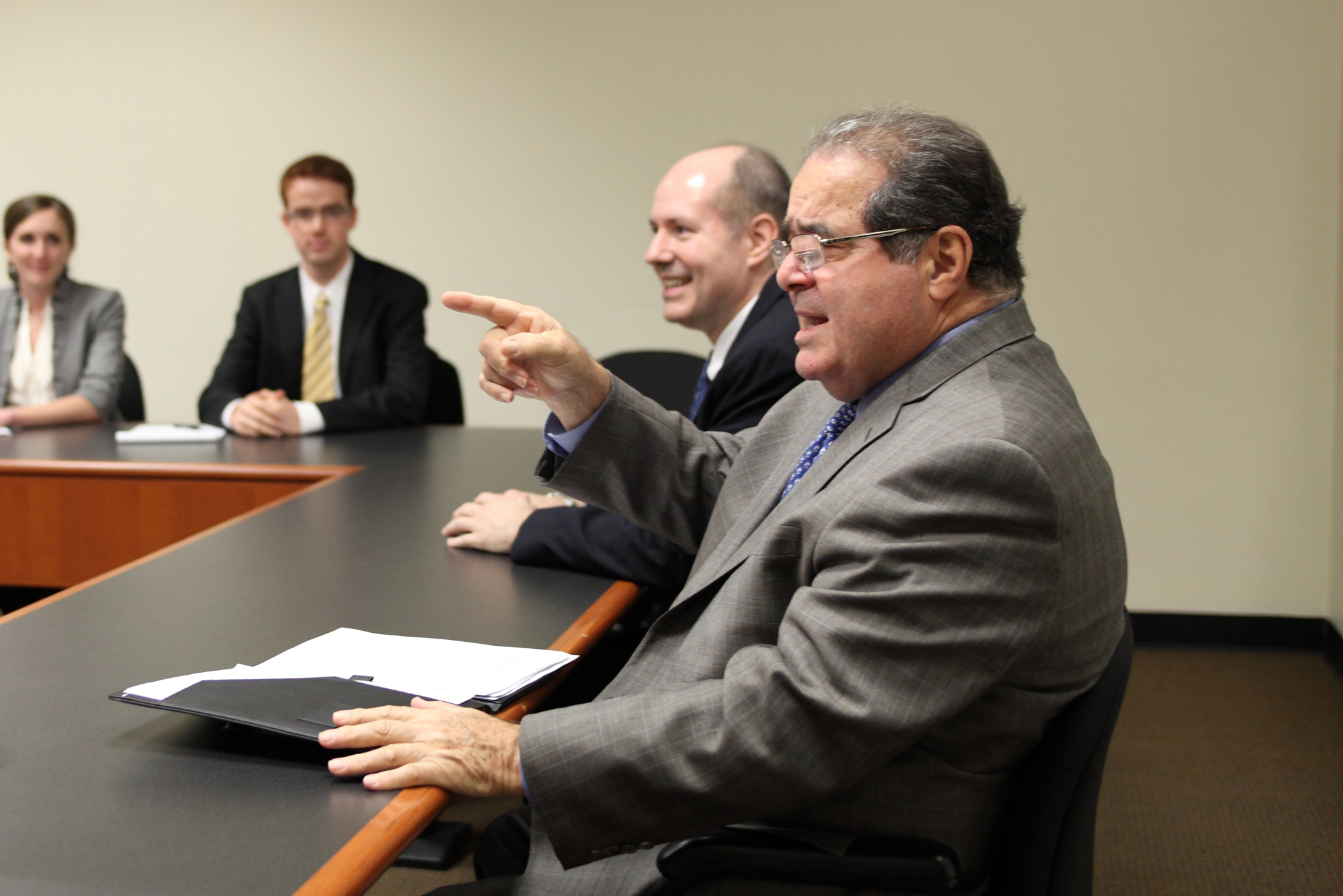The unexpected death of Supreme Court Justice Antonin Scalia on Saturday could have repercussions stretching far into the future. Not all of them, however, will be legislative.
Bradford Clark, William Cranch Research Professor of Law at the George Washington University Law School, knew the justice in a more personal context—as a boss and a friend.
Before his appointment to the Supreme Court, Justice Scalia was a judge on the U.S. Court of Appeals for the District of Columbia, where Mr. Clark clerked for another judge. “Judge Scalia and my judge were friends, and he would come by our chambers pretty regularly,” Mr. Clark remembered. “On one occasion, he asked me what I was working on, and then invited me down to his chambers to discuss one of his prior opinions relevant to the case.
“This kind of interaction by a judge with another judge’s law clerk was unusual, I think. But that’s the kind of person Justice Scalia was. He loved to engage with others about the law, and I think he particularly liked to engage with young people starting their legal careers. He was the same way when I clerked for him a few years later at the Supreme Court and remained that way throughout his years on the bench.”
George Washington Today spoke to Mr. Clark about Justice Scalia’s role on the bench, his “gregarious and generous” personality and the legacy he leaves behind.
Q: What was Justice Scalia’s role on the court?
A: Justice Scalia was known as a judicial conservative because he believed in judicial restraint, meaning that he believed that judges should adhere closely to the letter of the law and not inject their personal or policy preferences into their decisions. This judicial philosophy is today often characterized as “conservative,” but in reality it is not inherently conservative or liberal. For example, judicial restraint was championed by justices appointed by Franklin Roosevelt during the 1930s and ’40s. Democrats of the time believed that earlier Republican appointees had been engaging in judicial activism by reading their personal views into the Constitution, so they championed judicial restraint for decades. After the activism of the liberal-majority court led by Chief Justice Earl Warren in the 1960s, the roles were reversed, with liberal justices favoring judicial activism and conservative justices urging judicial restraint. I assume these roles could easily reverse again in the future.
Q: How has the Supreme Court been shaped by his time on the bench?
A: I think that Justice Scalia’s greatest influence on the court has been in changing the way the court approaches statutory and (to a somewhat lesser degree) constitutional interpretation. He believed in focusing closely on the text of the statute (or the Constitution) to decide cases. His preferred methods of interpretation were “textualism” and “originalism,” which seek to ascertain how a reasonably skilled user of language would have understood the enacted text at the time it was adopted. Since Justice Scalia joined the court, its opinions have become more textualist and more originalist due largely to his influence.
Q: What would you say were his most influential or characteristic pieces of writing?
A: Justice Scalia’s most important majority opinion was probably District of Columbia v. Heller, in which the court held that the Second Amendment protects the right of ordinary citizens to keep and bear arms for traditional purposes, such as hunting and protection of their homes and families. The case is notable not only for that holding, but for the originalist methodology the court employed in reaching its decision.
Justice Scalia probably issued his most influential dissent in Morrison v. Olson, in which the court upheld the constitutionality of the independent counsel statute by a vote of 7-1. Justice Scalia’s lone dissent argued that the statute violated the separation of powers and Article II of the Constitution. In retrospect, especially after Bill Clinton’s impeachment following an independent counsel investigation, many people looked at Justice Scalia’s dissent with fresh eyes and found it persuasive.
Q: In the short term, how will his death affect cases pending before the court?
A: If the court splits 4-4 in some pending cases, it will either have to hold these cases over for re-argument when a new justice is confirmed or affirm the lower court decision by an equally divided court. In the latter case, the ruling has no precedential effect, so the court could decide the issues presented again in a future case.
Q: Is it possible to summarize Justice Scalia’s legacy? How do you think he will be remembered?
A: It is hard to summarize his legacy in a short space because he was a true intellectual force on the court in many areas of the law. I believe he will be remembered as one of the most consequential justices in modern history because of the force of his intellect and reasoning, and because he was a particularly effective and persuasive writer both in his majority opinions and in his dissents. Oliver Wendell Holmes is often referred to as “the great dissenter” for his well-written dissents, and I believe that Justice Scalia’s opinions and dissents will likewise be remembered, cited and discussed for decades to come because of their quality.
Q: What was your impression of Justice Scalia as a person?
A: Justice Scalia was a generous and gregarious person. He liked people of all backgrounds and viewpoints, even those with whom he disagreed about the law. In fact, he genuinely enjoyed debating legal questions with people who held opposing viewpoints. He visited GW on numerous occasions and was always engaging and friendly with everyone. I particularly recall that when he dedicated a new building at the law school around 2002, he spent the entire day here, having lunch with and fielding questions from the faculty, dedicating the building at a ribbon-cutting ceremony and then meeting with hundreds of students at a reception.


